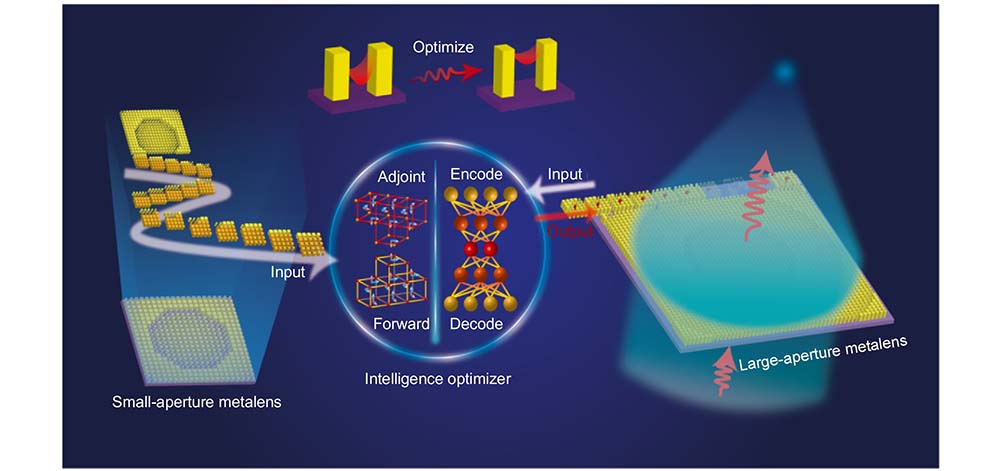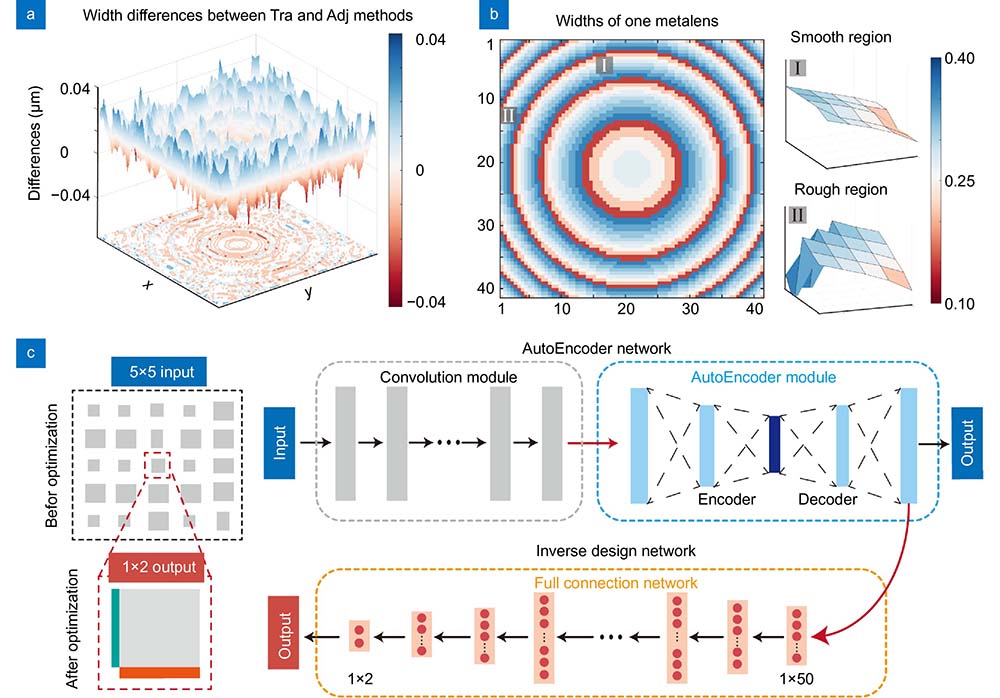Yingli Ha, Yu Luo, Mingbo Pu, Fei Zhang, Qiong He, Jinjin Jin, Mingfeng Xu, Yinghui Guo, Xiaogang Li, Xiong Li, Xiaoliang Ma, Xiangang Luo. Physics-data-driven intelligent optimization for large-aperture metalenses[J]. Opto-Electronic Advances, 2023, 6(11): 230133
Search by keywords or author
- Opto-Electronic Advances
- Vol. 6, Issue 11, 230133 (2023)

Fig. 1. Working principle of the “intelligent optimizer”. The “intelligent optimizer” incorporates both Adj and DL methods. Data-sets of the DL network are obtained from the small-aperture metalens optimized by the Adj method. Super meta-atoms of large-aperture metalens are fed into the network one by one. Output meta-atoms are spliced together to create a new metalens with improved focusing efficiency.

Fig. 2. Design method for the large-aperture metalens. (a ) The differences in widths distribution for the meta-atoms before and after optimization. (b ) The widths distribution of metalens, with the smooth region and rough region corresponding to translucent boxes I and II, respectively. (c ) The optimized network framework consists of an A-network that expands the information space of sampled data, and the weak coupling strength structures are filtered by the I-network.
Fig. 3. Simulation results of Adj and DL methods. (a ) Electric field distributions in the xy and xz planes designed by DL method for x- and y-polarized light, and the Adj method for x-polarized, respectively. (b ) Electric intensity profiles of the focal spot designed by theory, Adj, and DL methods, respectively. (c ) Width distributions of metalenses on y=0 plane (x>0) designed by the traditional (Tra), Adj, and the proposed methods, respectively. (d ) Width differences between the initial metalens and the optimized metalenses designed by the Adj method and our methods.
Fig. 4. Experimental results of optimized metalenses. (a ) The left image shows an overview of the device, with each diameter corresponding to four exposure doses. The inset is the optical microscope image. Scale bar: 100 µm. The right image is the scanning electron microscope image. Scale bar: 2 µm. (b ) The first row shows the focal plane intensity distributions of the three metalenses (100.5 μm, 500 μm, and 1 mm, from left to right, respectively). The second row shows the normalized focal intensity along the x-axis at the focal plane of the three metalenses. (c ) Focal intensity distributions in the xz plane at the three metalenses. (d ) Relative focusing efficiencies and Strehl ratios of three metalenses. (e ) Imaging results of elements #5 and #6 from group #7 of the USAF resolution target at 1 mm diameter optimized metalens (left) and 1 mm diameter ideal metalens (right). Scale bar: 5 µm.
| |||||||||||||||||||||||||||||||||||||||||||||||||||||||||||||||||||||||||||||||||||||||||||||||||||||||||||||||||||||
Table 1. Examples to show the representative parameters and performance of various methods.

Set citation alerts for the article
Please enter your email address



